Part of a series of articles titled Alaska Park Science - Volume 13 Issue 2: Mineral and Energy Development.
Article
Fire vs Ice: Revolutionizing the Thawing Process at Coal Creek
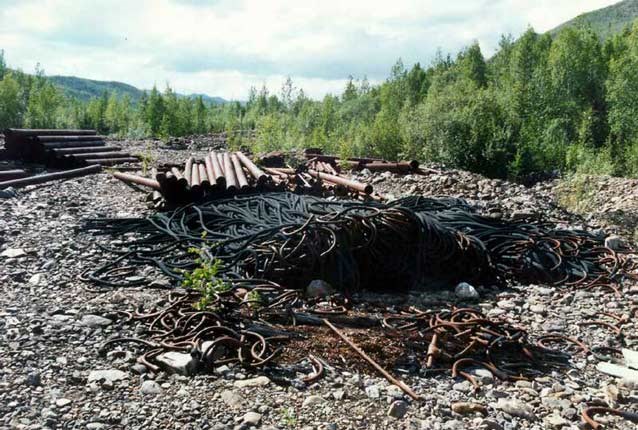
NPS/Douglas Beckstead, 1995
Gold mining is as much a part of the cultural and natural history of Alaska’s national parks as any other resource. In fact, in the enabling legislation of several Alaska park areas, gold mining is identified as one of the reasons that Congress deemed these areas worthy of protection.
Gold deposits are found in one of two forms: hard rock where intrusions (veins) extend into the surrounding host rock; and placer deposits where gold bearing rock has eroded and then is transported some distance away from its original location. Deposition in a placer deposit is explained through both simple physics and hydraulics. Gold, with a specific gravity of 19.32, is heavier than the other materials around it so seeks the lowest point in a slurry. (By comparison, lead has a specific gravity of 11.340, silver 10.490, copper 8.940, and iron 7.850.) As a result, when gold-bearing materials erode and are transported downhill by water, the gold works its way down to the bottom and collects at the contact between the bedrock and alluvial gravel (Spence 1996).
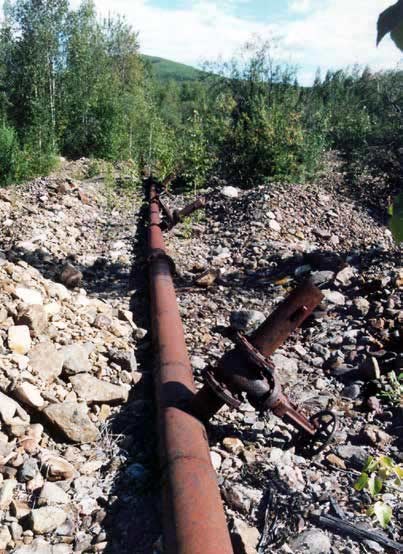
NPS/Douglas Beckstead, 1995
This same process has historically been used to recover gold from placer deposits. The overburden is removed, exposing the alluvial gravels, which are then processed through a mechanical device called a sluice. The sluice uses water flowing over riffles that allow the heavier gold to sink to the bottom while the lighter rocks, sand, and dirt move down and off the stern of the dredge.
Gold dredges mechanize the entire process of recovering placer deposits once the overburden has been stripped away. The giant chain of buckets continually scoops gravel, carrying it upward to where it is dumped into a hopper. From there, gravity and massive amounts of water carry the alluvial gravel down through a trammel that separates the largest rocks from the sand. The finer particles are washed down sluices that separate the gold from the sand. The sand then flows out the tail of the dredge and the gold is recovered during periodic cleanups. Dredges operated at various times on Coal Creek and Woodchopper Creek in Yukon-Charley Rivers National Preserve between 1935 and 1975.
The unique climatic and ecological conditions facing placer miners in Alaska requires them to carry out a complex stripping and thawing process before beginning to work the gold-bearing alluvial materials below. At Coal Creek and Woodchopper Creek, bulldozer operators stripped away the trees, brush, and tundra that formed an insulating blanket over the ground. This exposed a shiny, black surface of frozen muck varying in depth between 6 and 26 feet.
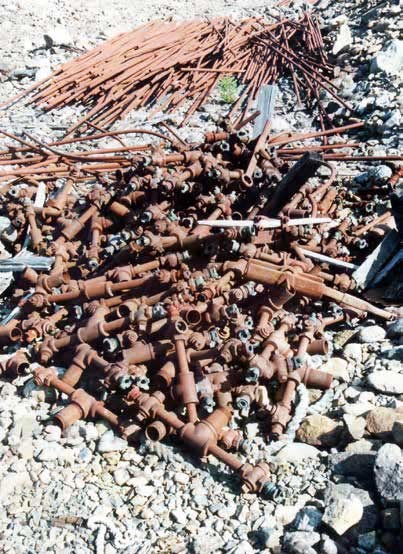
NPS/Douglas Beckstead, 1995
This permanently frozen gravel, or permafrost, was as resistant to the bulldozers as reinforced concrete. During the first operating season (1935), Gold Placers Inc. relied upon steam thawing to prepare the ground for dredging.
This process involves driving steam points, sections of one-inch diameter pipe with a hardened chisel point connected to high-pressure steam hoses, into the permafrost. The steam escapes through the tip, thawing the surrounding gravel. Over the winter of 1935-36, Gold Placers contracted with several local woodcutters to cut and stockpile approximately 250 cords of wood needed to fire the 40-horsepower boiler they used during the first season of thawing operations (Patty 1936).
Thawing fell under the jurisdiction of the dredgemaster, Fred Obermiller, based on his years of experience with similar operations at the Fairbanks Exploration Company. When the Coal Creek dredge started working the steam-thawed ground, initial reports called conditions “nearly perfect.” This optimism was short-lived when the dredge struck ground that had re-frozen over the winter. Patty noted in the company’s first annual operating report that “The steam thawed area embraced 18,000 cubic yards and cost 34 cents per yard . . . and proved worse than useless. This steam thawing, when successfully done, is very expensive and will not be attempted in future seasons” (Patty 1936).
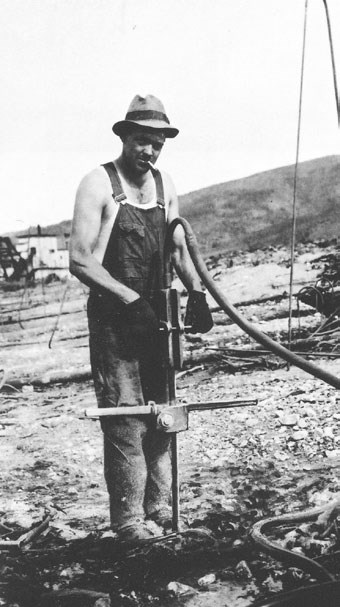
Photo by Ernest Patty, 1936, courtesy of Douglas Beckstead.
When steam thawing proved to be such a failure, Patty turned to a new technique of using cold water drawn from the same ditch that channeled water from Coal Creek used for stripping.
Cold-water thawing is similar to using steam except that, as the name implies, cold water is used. As soon as the strip-ping crew finished and moved on to new areas, the thawing crew moved in with their lines of hydraulic hoses, pipes, and points. Cold-water points consist of a 10-foot length of heavy gauge pipe, 7/8 of an inch in diameter, with a hardened chisel welded to one end. The upper end is threaded for connecting a hose or additional sections of pipe as the point man, using a slide hammer, drove the pipe deeper into the gravel. Water under pressure flowed through the pipe and slowly seeped into the gravel through two holes on either side of the point. As the ground slowly thawed, the points were driven deeper and deeper into the gravel, continuing the thawing process.
Patty estimated that water flowing into the pipes from the hillside ditch had a temperature of approximately 45 degrees Fahrenheit (7.2 degrees Celsius). When it flowed out of the ground around the thaw points it had cooled to approximately 35 degrees Fahrenheit (1.6 degrees Celsius). Thus, the water transferred approximately 10 degrees Fahrenheit of “heat” to the ground to facilitate the thawing process, all at a minimal cost to the company (Patty 1969). By mid-July, sufficient ground was thawed to allow dredging operations to begin. Patty estimated that by the end of the summer, using hydraulic stripping and cold-water thawing, “sufficient ground would be stripped for one or two years ahead” (Patty 1969; Patty 1935).
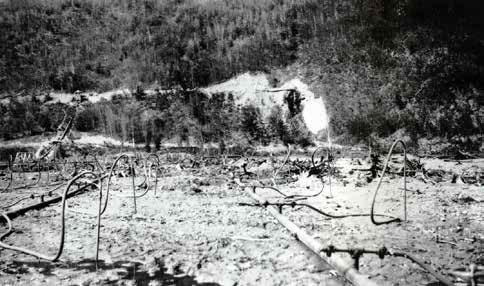
Bill Lemm Collection, NPS
The 1936 season started when the first 250 cold-water thawing points were driven on May 18. Within two weeks, all of them had reached bedrock and were, as Patty noted, “doing good work.” An additional 250 points were on hand; however, the flanged feeder pipe to supply them was due on the first down-river boat from Whitehorse on June 5. Unfortunately the White Pass & Yukon Route failed to load them on the first boat although arrangements had been made months in advance. Instead, the pipe was loaded on the steamer Klondike, which sank, taking the pipe with it. The company placed a duplicate order that arrived in late July. In addition, they were able to salvage some of the original order from the wreck (Knutson 1979). An additional order of points arrived in August, and a final order for 250 more points that would go into service in 1937 arrived late in the season, providing the company nearly 1,000 points for thawing. Most of these are still in the Coal Creek pipe yard.
Much to the amusement of the crew, occasionally when General Alexander Duncan McRae, the owner of the operation, was at the camp he would walk out and inspect the operations. Several times while crossing the thawing fields, the surface appeared solid when, in fact, it generally had but a frozen crust over the thawed gravel below. On more than one occasion, McRae (he was a rather large man, in stature and girth) broke through, sending him waist deep into the cold gravel and water below. Reports had it that “the boss” always took it in stride and made a joke of it, although it must have been an extremely cold joke (Lemm 1992).
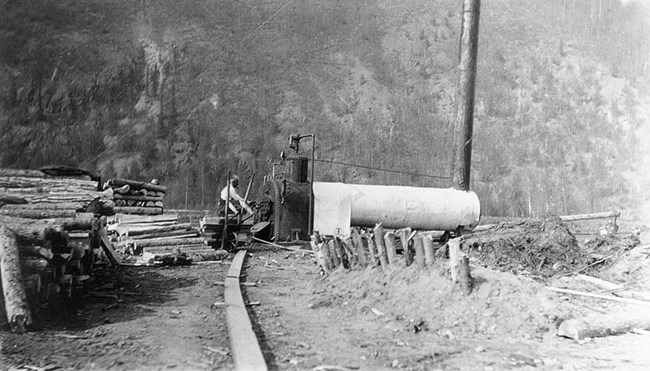
Courtesy of Sherrie Harrison
Because of the problems associated with getting the points and feeder pipes delivered, there was not sufficient ground thawed ahead of the dredge to operate for the entire season. The dredge shut down on October 5, 1936, a full month ahead of schedule (Patty 1936).
Unlike steam thawing, water thawing proved so successful that during the 1936 season, with the exception of the steam-thawed ground that re-froze, the dredge was never bothered by frost in water-thawed gravel. This proved the new method to be reliable and more thorough than the old practice of steam thawing. Its use at Coal Creek was the first in the Eagle-Circle mining district. Gold Placers maintained careful records to enable confident replication elsewhere. The practice was soon adopted in the goldfields around Fairbanks (Patty 1936).
The Economics of Dredging
The success or failure of any gold mining operation lies in the economics of how the venture is run. This takes into account not only such tangible costs as equipment, wages, and fuel, but also costs of such things as deposits on containers. During the mid-1990s, the National Park Service undertook a project to gather all of the abandoned drums scattered throughout the Coal Creek drainage. Much to their surprise they did not find any “old” barrels. Almost all of those gathered for recycling were dated to the late 1960s and 1970s. The question was posed of how could the dredging operation from 1935 to 1960 not leave fuel barrels scattered about the landscape?
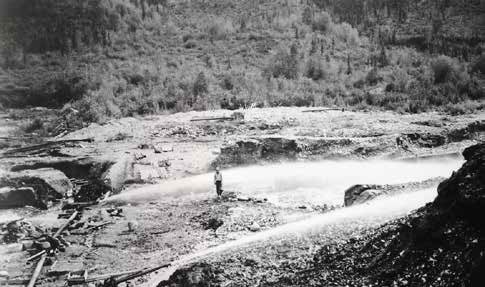
Bill Lemm Collection, NPS
When the original plans were being laid for purchasing a dredge to work Coal Creek, the Walter W. Johnson Co. stated that the dredge would be powered by two Atlas engines, one to power the digging ladder, winches, screen, etc., and the other to power two pumps. These engines combined would consume approximately 180 gallons (681 liters) of fuel per day. The company engineer, A.P. Van Deinse, recommended that Gold Placers should have a 10,000-gallon (37,850-liter) supply of fuel on hand when the dredge began operation. This would amount to approximately a 50-day supply for the dredge and tractors and would give them sufficient time to have a resupply late in the season that would take them through the end of the season and the beginning of the next (Van Deinse 1935).
During the first decade of operation, transporting fuel from Whitehorse to Coal Creek via barges of barrels was not much of an economic hardship. Full barrels were transported down the Yukon and off-loaded at the Coal Creek landing and empty barrels were put back on the barges and taken back to Whitehorse where they were refilled. Between 1942 and 1946 operating costs increased approximately 26 percent while the price of gold remained constant at $32.00 an ounce; it was necessary to find ways of cutting costs to maintain profitability. One of those ways was to cut out the deposits on fuel barrels (Patty 1946).
To accomplish this, a decision was made to construct a large oil tank high on the bank above the Yukon slightly downstream from Slaven’s Roadhouse (the piping from this tank is still visible today). Fuel was then transported down the Yukon in a large tank on a barge. It was off-loaded and pumped up to the holding tank at Slaven’s Roadhouse. When fuel was needed at the camp, a tractor would pull the Athey wagon, the large, tracked wagon that remains at Coal Creek Camp today, down to the Yukon where a smaller tank on the wagon was filled. This was then hauled up to the dredge and the fuel transferred once again. In addition it could be pulled throughout the valley to refill various tractors, etc., as needed. As a result, all of the empty fuel barrels that had been used previously were shipped back to Whitehorse and the deposits refunded to Gold Placers (Patty 1998a).
The management of Gold Placers, Inc. and Alluvial Golds continued to make similar attempts to cut operating expenses as inflation continued to rise while the price of gold remained constant. Eventually, by the 1960 season, a decision was reached by Dale Patty and the Board of Directors to close the operation permanently. In Dale’s words, “We cleaned up and left. That was October 1960 and the last time I have seen the mines” (Patty 1998b).
Read more about thawing operations at the Coal Creek Historic Mining District.
References
Janin, C.
Manuscript Collection. Henry E. Huntington Library. San Marino, California.
Knutson, A.E. 1979.
Sternwheelers on the Yukon. Kirland, Washington: Knutson Enterprises, Inc.
Lemm, B. 1992.
Interview with Don Chase, Fairbanks, Alaska, June 19-21. Transcript in the collection of Yukon-Charley Rivers National Preserve.
Patty, D. 1998.
Coal Creek and Woodchopper Creek Mining. June 12. Unpublished manuscript in author’s possession.
Patty, D. 1998.
Interview with Douglas Beckstead, Coal Creek, Alaska, July 19. Transcript in the collection of Yukon-Charley Rivers National Preserve.
Patty, E. 1935.
Letter to Walter W. Johnson Co, May 27. Janin Manuscript Collection.
Patty, E. 1936.
Operating Report, Gold Placers Inc.
Patty, E. 1946.
Operating Report, Gold Placers, Inc.
Patty, E. 1969.
North Country Challenge. New York: David McKay Com-pany, Inc.
Spence, C. 1996.
The Northern Gold Fleet: Twentieth-Century Gold Dredging in Alaska. Urbana: University of Alaska Press.
Van Diense, A.P. 1935.
Letter to Patty, Ernest, June 7. Janin Manuscript Collection.
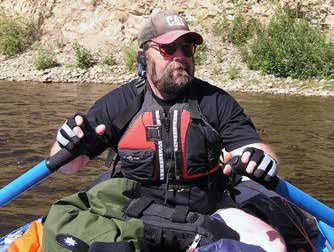
Remembering Doug Beckstead
Doug Beckstead passed away at home in Anchorage on July 1, 2014. His dedication to preserve the history of Alaska and the United States will long be remembered by those whose lives he touched and whose accomplishments he recorded. During the 16 years that Doug worked with the National Park Service (NPS) in Alaska he authored the book The World Turned Upside Down, a historic narrative of the men and women who worked the gold deposits at Coal Creek and Woodchopper Creek in what is now Yukon-Charley Rivers National Preserve, and began the research for this article.
Doug also assisted the NPS Alaska Region’s Special Events Team as a commissioned firearms instructor and was assigned on detail to the Anchorage Police Department (APD) during the 1990s, conducting historical research about police officers who had been killed in Alaska and patrolling with APD officers downtown. In 2006, Doug joined the 3rd wing Joint Base Elmendorf Richardson as a military historian, and deployed three times to combat zones in Iraq and Afghanistan to record living history of military operations there.
Last updated: August 31, 2020
